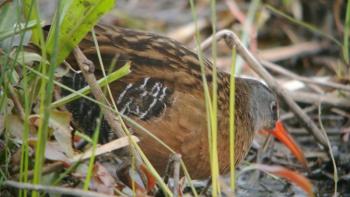The sound was as clear as could be, a distinctive “kidick, kidick.” That’s one of the sounds made by the Virginia rail. Rails are generally very secretive birds that inhabit wetlands with significant cover. Here in Maine, that’s usually a cattail marsh. Virginia rails, looking a bit like a mini-chicken in shape but with reddish underparts, a gray face, and a long, reddish bill and long toes, are adept at slinking around through narrow spaces between the cattails. More often than not, the only signs of their presence are their calls. One of these calls sounds a bit like the sound made when striking two hard wooden dowels together quickly: “kidick, kidick, kidick, kidick.” Another call sounds like a low grunting.
We have heard those distinctive sounds of Virginia rails emanating from cattail marshes here in Maine many times. At one of our favorite marshes that we visit quite often, we have even been lucky enough to see birds emerge briefly from the thick cattails into the open shoreline—a reward for sitting quietly for a long time.
But that’s the exception to the rule.
The Virginia rail call that we heard last week, though, was not coming from a marsh. In fact, it wasn’t even coming from anywhere on the ground. Instead, it was high above our heads in the night sky. We heard it while we were giving our dog one last short neighborhood walk in the dark before heading off to bed.
There’s a sort of thrill in hearing such a distinctive bird in a situation like that. It seems to somehow encapsulate the wonder and mystery of the incredible migratory journeys that birds undertake across our planet. We could imagine that bird, hundreds of feet above our heads, looking down on the lights from towns and roadways and cars, beating its wings with the single-minded purpose of getting to a particular wetland where it was expecting to find a mate and carry on the cycle of life.
In the East, Virginia rails spend the winters along our southern coasts down into Florida and across into Mexico. Presumably this single bird that we heard overhead had begun migrating some days or weeks before, from a spot somewhere in that region. And now, here it was this cool night likely getting quite close to where it would spend the summer, since the breeding range extends only a few hundred miles beyond Maine into southern Quebec.
We have heard that distinctive “kidick, kidick” from the night sky before over our house during April migration, so we know it is a generally regular event. Still, it is infrequent, and it comes at a time when there are few other birds that we hear in night migration. So we always feel unbelievably lucky whenever we hear one.
As the days slide into May and the numbers and diversity of migrating birds reaches its spring peak, there will be nights when the sky above will almost echo with the calls of thrushes and warblers and sparrows. And we look forward with anticipation to those coming nights.
But now, as the wave of migrating birds is just beginning to swell, we savor the sound of that lone Virginia rail, unseen on its miraculous migratory journey.
Jeffrey V. Wells, Ph.D., is a Fellow of the Cornell Lab of Ornithology and Vice President of Boreal Conservation for National Audubon. Dr. Wells is one of the nation's leading bird experts and conservation biologists. He is a coauthor of the seminal “Birds of Maine” book and author of the “Birder’s Conservation Handbook.” His grandfather, the late John Chase, was a columnist for the Boothbay Register for many years. Allison Childs Wells, formerly of the Cornell Lab of Ornithology, is a senior director at the Natural Resources Council of Maine, a nonprofit membership organization working statewide to protect the nature of Maine. Both are widely published natural history writers and are the authors of the popular books, “Maine’s Favorite Birds” (Tilbury House) and “Birds of Aruba, Bonaire, and Curaçao: A Site and Field Guide,” (Cornell University Press).


_(5821965911).jpg)

























